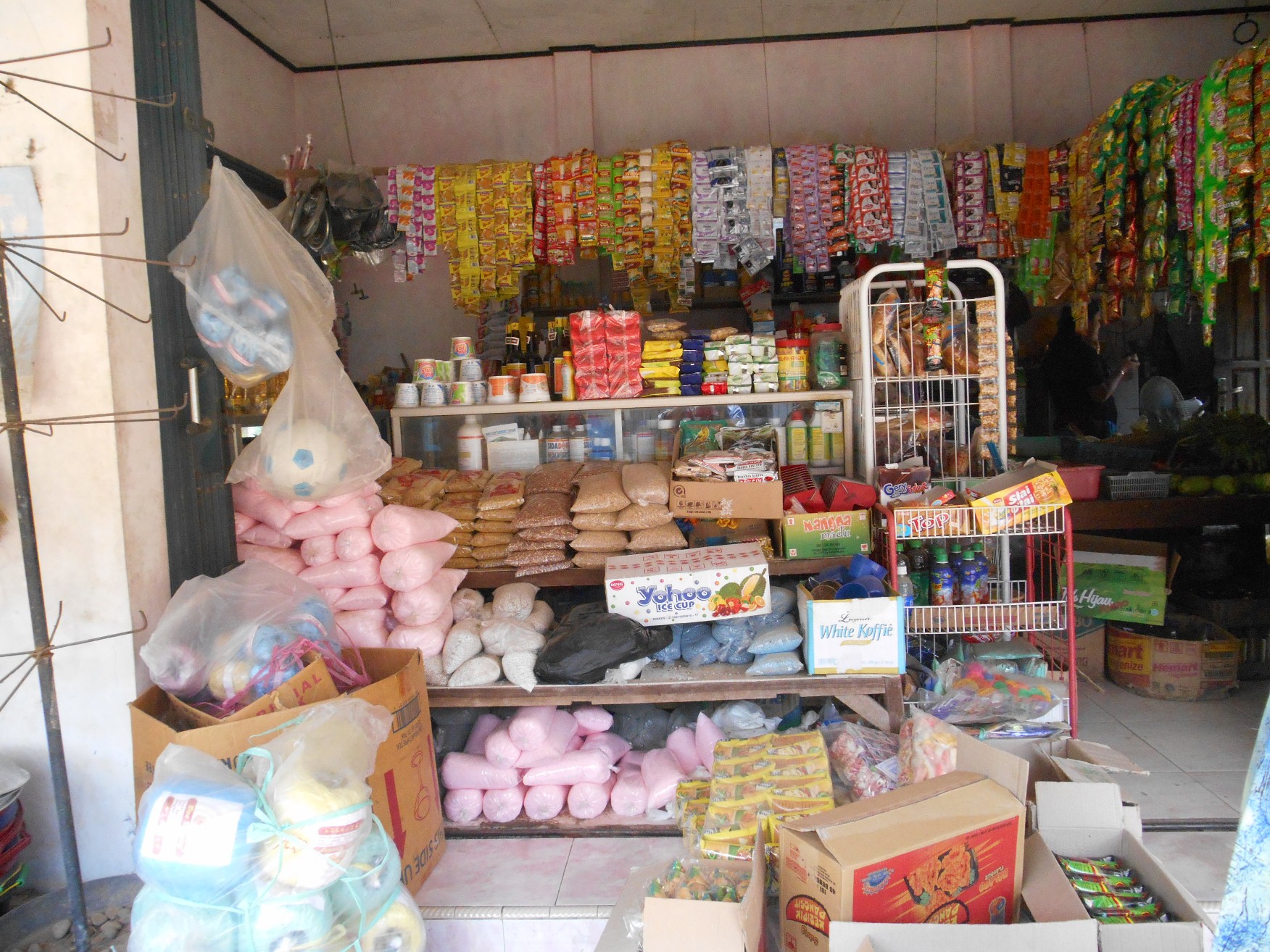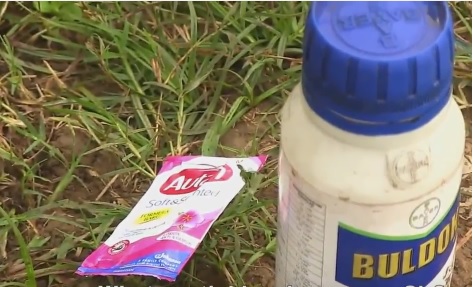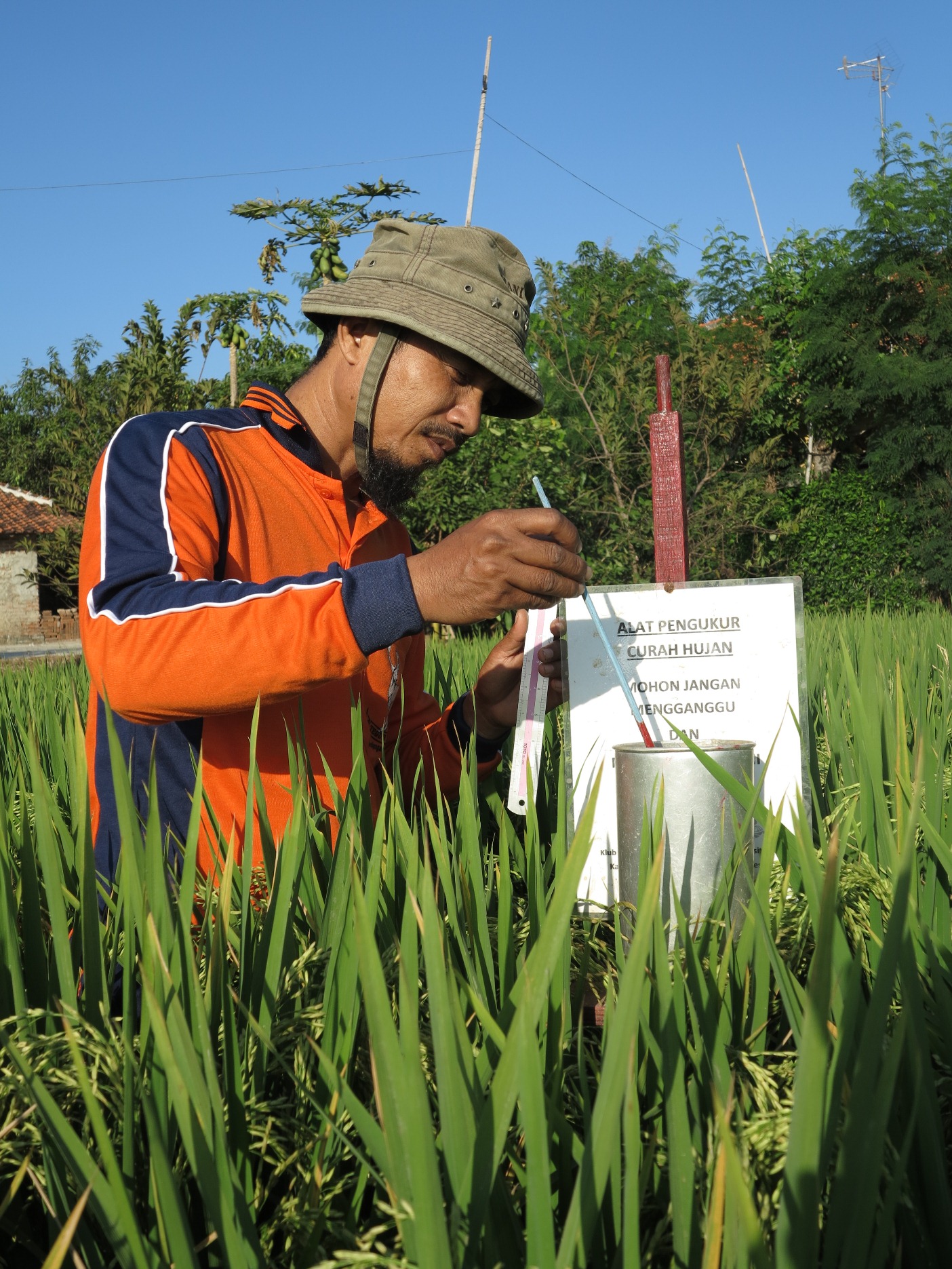Over-use of pesticides is making the crops ‘sick’, but only farmers educated about the environment understand this
Muki T. Wicaksono, Yunita T. Winarto, Kees Stigter, Aria Sakti Handoko, Ubaidillah Pratama, Febry Sulistya
‘Farmers here rely on rice fields. Our families will struggle if our rice fields cannot produce income,’ said Dadi while sitting in his small house in Indramayu in West Java. It was the fallow season of 2014. He explained that many farmers believe that the use of ‘medicine’ will lead to increased rice production. ‘Medicine’ is the colloquial term for ‘pesticide’ and farmers say it prevents their crops from getting ‘sick’. But Dadi believes that the over-use of chemical pesticides ‘is the most difficult problem in our life.’
Little is known about the main environmental problems that farmers face in Indonesia at present. Even less is known of the problems that farmers will face in the future. Farmers wonder, ‘Why is it that the more “medicines” we use, the more ‘illnesses’ infest our paddies?’ Not only are farmers trapped by their dependence on pesticides, introduced as ‘medicines’ to them during the Green Revolution, but also they lack understanding of the ecosystems produced by the Green Revolution technology.
Farmers in Indramayu believe that over-use of pesticide is the most important environmental problem that they face at present. This was the finding from a survey of 100 farmers (76 farmers from Indramayu and 24 from East Lombok). ‘The rice field ecosystem has been degraded compared to the old days prior to the Green Revolution. Back then, I could still find crabs and fish, and drink the water from the rice fields. Now, we would be poisoned if we drank the water from the rice fields. It is contaminated by fertilisers and pesticides that contain chemicals,’ said one of the farmers from Indramayu.
Dadi and the others are all farmers who participate in so-called ‘Science Field Shops’ – a new approach to agricultural extension. Traditionally, agricultural extension agents have passed on the government’s information in top-down communications to farmers. This new approach uses an adult learning method prepared by and for farmers and by experts in agrometeorology and environmental anthropology. Farmers have monthly meetings in farmers’ houses where they spend time in discussion, as they would in a small neighbourhood shop, or warung. At the meetings, the farmers report their rainfall and agroecosystem data from the past month, and discuss the issues they face, such as pest and disease outbreaks, flood, drought, and water management problems. Through these discussions in so-called Science Field Shops (SFS), they share experiences to solve their challenges.
Groups of farmers joined the SFS from 2010 in Indramayu and from 2015 in East Lombok. They learned to measure and record rainfall and observe their rice field ecosystems every day, becoming ‘rainfall observers’. The aim was to identify problems and opportunities in their farming by understanding the impact of variable rainfall on the fragile ecosystems of rice fields. By collaborating with an agrometeorologist and anthropologists through the SFS, these rainfall observers became ‘farmer-researchers’ – villagers who learn to know their environmental ‘enemy’ better through agrometeorological learning activities. The most serious problem the farmers face is the increased intensity of pest and disease infestation under particular rainfall conditions, which is exacerbated by the excessive use of pesticides that kill pests’ natural enemies.
Farmers organised themselves to form the Indramayu Rainfall Observers Club and the East Lombok Rainfall Observers Group. The term ‘club’ was chosen by Kees Stigter, the agrometeorologist, who was inspired by the concept of football clubs. The idea was that every farmer could join a club to learn together through SFS to improve their capacity to adapt to climate change and thus avoid harvest failure, and to sustain yields in the midst of increasing uncertainty and risk.
Identifying the ‘enemy’
The over-use of pesticides is one of the topics discussed in the SFS. Using chemical pesticides to prevent and control outbreaks of pests and diseases has been common since the introduction of the Green Revolution in Indonesia in the 1970s. In Indonesia the Green Revolution brought about agricultural development through the building of irrigation canals and the introduction of chemical fertilizers and pesticides and high yield varieties of rice to increase national rice production. However, one devastating consequence of the Green Revolution was the severe outbreaks of brown planthopper (BPH, Nila parvata lugens) in 1985, just one year after the declaration of Indonesia’s self-sufficiency in rice.
The government responded by enacting Presidential Regulation No. 3/1986, to improve brown planthopper control. Integrated Pest Management (IPM) was declared the national strategy in controlling pest and diseases. It entailed the banning of 57 brands of organophosphate pesticides, and the implementation of an educational program for agricultural staff and farmers all over Indonesia in the form of ‘Integrated Pest Management-Farmer Field Schools’ (IPM FFS). In these ‘schools’, farmers learned to observe their fields weekly, and to conserve natural enemies (predators and parasitoids) – in short, how to grow a healthy crop. The training focused on the role and function of natural enemies so that farmers could identify which insects were helpful and which were pests that had to be controlled. They became IPM experts in their own fields. Farmers who attended IPM FFS knew the pests and diseases in their fields and were able to control them by conserving natural enemies in rice fields. One of the major outcomes of the IPM FFS was the restoration of balance in rice field ecosystems.
After participating in IPM FFS, most farmers chose to reduce the use of chemical pesticides, and to conserve natural predators, such as spiders, snakes, ladybugs, etc, and parasitoids, so that pest populations and outbreaks of disease were naturally controlled without the over-use of pesticides.
The SFS have their predecessors in the IPM FFS. However, there are only a small number of IPM FFS, and the government persists with using the chemical paradigm to increase national rice production in Indonesia.
Knowing the enemy
Farmers in both Indramayu and East Lombok perceived that the worst problem they faced in their rice fields was the increasing pest and disease infestations. However, there is a big gap between Indramayu and East Lombok farmers in terms of their understanding and use of chemical pesticides. Farmers in Lombok had never participated in the IPM FFS, where this issue was taught, so none of them identified the over-use of pesticides as the main environmental problem in their local area. In contrast, 13 per cent of Indramayu farmers, who were mostly familiar with IPM FFS strategies, perceived that the over-use of pesticides contaminates their rice ecosystems by reducing the number of natural predators and parasitoids (or natural enemies) of pests in their fields. In addition, nearly 20 per cent of surveyed Indramayu farmers perceived that the wrapping from pesticide packaging contaminated their rice fields.
A rainfall observer from Indramayu said ‘the more pesticides are sprayed, the more the pest and disease populations increase’. Many Indramayu (26 per cent) and East Lombok farmers (29 per cent) thought that ‘the increasing pest and disease populations in the rice fields’ was the main environmental problem in their local habitat. But only Indramayu farmers understood the impact of the over-use of pesticides on pests and diseases. One farmer said: ‘Based on my observations, I saw that many pests and diseases became more resistant when I frequently sprayed chemical pesticides.’
Farmers in Indramayu and East Lombok often sprayed pesticides in ‘cocktail’ mixes of two or more insecticides, insecticides and herbicides or fungicides, or insecticides combined with a mosquito repellant or other substances. During the rainy season of 2014, 254 types of pesticide cocktails were being used in one village in Indramayu, which amounted to 2231 litres and 1.15 tons of pesticides. This number increased to 335 types of pesticide cocktails by the dry season of that same year, equalling more than 3000 liters and 1.4 tons of pesticides. These data were collected from our survey on the over-use of pesticide in Kertawinangun village, Indramayu. According to one farmer, they believed that by mixing the pesticides, they would strengthen the ‘medicine’ .
Farmers now live in a poisoned environment. Some complained of health issues after spraying pesticides in their fields. ‘I get headaches after spraying pesticides, but I have no idea what the reason is,’ said one of the farmers in East Lombok. Some kiosks in Java freely sell pesticides alongside other food items. Private pesticide companies are often found visiting farmer groups to promote their latest products. Farmers welcome the t-shirts and discounts that they receive for purchasing their pesticides. The pesticides are sold freely in almost every village in Indramayu and East Lombok. The amount of money spent per season on pesticides, for example, by farmers in Kertawinangun village in Indramayu, is more than one billion rupiah (US$76,000). Chemical pesticides are a part of most Indonesian farmers’ daily consumption.
Pesticide ‘cocktail’ mixes with mosquito-repellant in Indramayu - Credit: Center for Anthropological Studies – Universitas Indonesia in collaboration with ARCDG, DP130100051, 2013 / Rhino Ariefiansyah
In East Lombok, farmers persistently rely on the Green Revolution packages of chemical fertiliser, irrigation water supply and pesticides. In the survey, some farmers (21 per cent) complained about the scarcity of chemical fertilisers during the first fertilising stage of the tobacco season, while others (13 per cent) complained about poor irrigation or drainage systems in their fields. Some Indramayu farmers who had received the IPM FFS training mentioned the problems of soil quality degradation (7 per cent) and ecosystem degradation (5 per cent).
These survey results show that differences in learning experiences produce different perceptions of environmental enemies, with farmers in each site identifying a different environmental problem as the main issue they face. The East Lombok farmers have had a shorter period of agrometeorological learning through SFS than Indramayu farmers. The existence of some IPM FFS alumni and farmer-facilitators in Indramayu played a significant role in the learning process of other Indramayu Rainfall Observers Club members. This was absent in East Lombok.
‘For farmers, farming activities are always about learning, and there is no “sufficiently knowledgeable” farmer. We always learn, every time, from season to season, month to month.’ That was the message of rainfall observers, when we asked, ‘Why do you keep learning about agrometeorology in SFS?’ The monthly SFS meetings gave farmers opportunities for direct dialogue among farmers and between farmers and scientists to discuss and solve their current agro-ecosystem problems such as those related to climate issues.
Rainfall observers measuring rainfall in Indramayu - Credit: Center for Anthropological Studies – Universitas Indonesia in collaboration ARCDG, DP130100051, 2016/ Aria Sakti Handoko
Who is responsible?
Unfortunately, rainfall observers are only a small part of the entire farming community. They are also the subjects of government, at various levels, and are only receivers of government decisions – not decision-makers. Our survey asked farmers who they think is responsible for solving environmental problems in their area. Farmers in Indramayu and East Lombok identified the responsible parties as follows: (1) government (29 and 42 per cent respectively); (2) farmers in their own fields (22 and 13 per cent); (3) society (20 and 8 per cent), and (4) both farmers and government (16 and 8 per cent). It is interesting that both Indramayu farmers (22 per cent) and East Lombok farmers (13 per cent) included themselves as responsible parties.
Tackling the enemy
The job of tackling the enemy in the rice fields is now in the hands of the farmers themselves, and they have begun to be active decision-makers in doing so. However, in their view, the government is the most responsible agent. Farmers realise that it is beyond their capability to solve the severe and large-scale problems by themselves.
During the SFS monthly evaluation meetings, farmers can share experiences, not only of the strategies each of them develops under certain weather conditions, but also of the outcomes, leading to improvement in farming strategies. The rainfall observers believe that they can contribute to solving their environmental problems in their own habitat. Some Indramayu rainfall observers (12 per cent) reported that they switched to organic pesticides in order to restore the polluted rice fields to their unpolluted condition; others (11 per cent) said they had reduced the use of chemical pesticides. Dirham, an Indramayu farmer, said to some of his colleagues, ‘I tried to tell my findings to other farmers here. Principally, I told them about the issue of natural enemies. We do not need to spray pesticide. The BPH population is actually controlled by natural enemies. It is true! I saw BPHs being eaten by a frog in my field.’
The varied responses of farmers in the two places show that the longer the farmers learn, the more knowledgeable they become. Even though farmers realise that their ‘enemy’ – the cause of the problems – is far beyond their reach, they also have to rely on the government to solve the recurring problems and the causal factors (e.g. pesticide promotion). A significant number of Indramayu rainfall observers refer to themselves, sometimes in collaboration with the government, as the agent which is responsible for solving their problems. The continuous dialogue and interaction between farmers and scientists as well as other parties provide a good opportunity for the farmers to find answers to the puzzling questions they face daily. It helps them know their ‘enemy’ better so that together, they can develop sound farming strategies.
Their awareness and capability as practitioners in their environment help farmers to not only sustain their learning in SFS, but also to invite other farmers to join the learning process and disseminate their new knowledge to as many other farmers as possible. Can such energy be sustained in the future? Can it motivate a larger number of farmers to join and encourage local policy-makers to support them? Further collaborative work is indeed necessary.
Muki T. Wicaksono (muki.wicaksono@epistema.or.id) was a researcher at the Center for Anthropological Studies, Faculty of Social and Political Sciences, Universitas Indonesia (2012 to 2015) and is now a junior researcher at Epistema Institute, a research-based institution on law, society, and environment issues.
Yunita T. Winarto (yunita.winarto@gmail.com) is professor in anthropology, Department of Anthropology, Faculty of Social and Political Sciences, Universitas Indonesia.
Ubaidillah Pratama (ubaidillahpratama@gmail.com), Aria S. Handoko (ariasakti.ui@gmail.com), and Febry Sulistya (febry.sulistya.pam@gmail.com) are from the Center for Anthropological Studies, FISIP, Universitas Indonesia where they were also research team members during the Environmental Education Survey conducted in collaboration with Australian Research Councils in the period of 2013 to 2015.
The late C. (Kees) J. Stigter from Agromet Vision (the Netherlands, Indonesia, and Africa) collaborated with the Cluster for Response Farming to Climate Change, Environmental Anthropology Section at the Center for Anthropological Studies, FISIP-UI.


